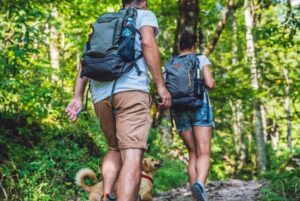10 things you should know before going hiking with a dog
 10 Tips for Hiking With Your Dog in Saratoga & Campbell, CA
10 Tips for Hiking With Your Dog in Saratoga & Campbell, CA
Going hiking with your dog can be an exciting adventure, but it can also pose certain challenges. Nestled in the scenic Santa Clara Valley, Saratoga and Campbell, CA, offer a haven for hiking enthusiasts and their dogs. With their close proximity to the Santa Cruz Mountains and a temperate climate year-round, these charming areas boast a variety of dog-friendly hiking trails. From serene strolls along shaded creeks to challenging ascents to scenic vistas, there’s something for everyone to enjoy. However, before you hit the trails, there are important things you should know to ensure a safe and enjoyable experience for both you and your dog. Here are 10 things you should know before going hiking with your dog.
Know the Trail
Research the trail beforehand to understand its difficulty level and potential hazards, such as steep climbs or narrow paths. Knowing the trail’s features, like elevation changes and shaded areas, will help you plan for your dog’s comfort. If your dog is new to hiking, start with shorter and easier trails so they can adjust to the outdoor experience. Check for specific rules and regulations set by the trail. Some trails do not allow dogs or have designated dog trails. Make sure you respect the rules and stay on designated trails.
Know Your Dog’s Limits
For a safe and enjoyable hiking experience with your dog, consider their breed, age, and fitness level. Choose a trail that matches their abilities and start with shorter, less strenuous hikes if they are new to hiking. Not all dogs are the same, and their fitness levels can vary greatly. High-energy breeds may enjoy more challenging trails, while older or less active dogs might do better with shorter ones. Always consult your veterinarian if you have any concerns about your dog’s hiking ability.
Poisonous Plants Awareness
Familiarizing yourself with the potential presence of toxic plants on your chosen hiking trail is paramount for your dog’s safety. Keep an eye out for poison ivy, poison oak, and poison sumac, which can cause severe skin irritation and discomfort for both you and your dog. Additionally, be cautious of plants your dog may be tempted to chew on, like mushrooms and berries, as they could be toxic and lead to digestive issues or worse. Staying informed about the local flora will help you avoid allowing your dog to interact with unfamiliar vegetation.
Wildlife Awareness
While enjoying the natural beauty of Saratoga and Campbell, CA, it’s essential to be aware of the local wildlife that might share the trails with you and your dog. Keep an eye out for potential encounters with creatures like deer, coyotes, and raccoons, especially during dawn and dusk when they are more active. Though these animals are usually timid, it’s best to keep your dog on a leash to prevent unexpected interactions. Dogs are pack animals and enjoy socializing. However, wildlife can be dangerous for your pup. Additionally, watch for snakes, such as rattlesnakes, which can be found in the area. Educating yourself about the local wildlife can help you and your dog stay safe during your hike.
Pack Essentials for Your Dog
Just as you prepare for a hike with essentials like water, snacks, and safety gear, it’s equally important to ensure your furry hiking companion is well-equipped. Whether planning a quick trek or a longer expedition, ensuring your furry companion has the necessary gear and supplies can help create a positive and enjoyable experience for you and your dog. Here’s a comprehensive list of items to pack for your dog to ensure their comfort, safety, and well-being during the adventure:
- Water – It is important to carry enough water for both you and your dog. Dehydration is a common issue both hikers and dogs face, especially during long and hot days. A good rule of thumb is to carry at least 1 liter of water per person and 0.5 liter of water per hour for your dog. Collapsible water bowls are a convenient choice, allowing your dog to drink easily.
- Food – Depending on the duration of your hike, pack enough dog food in a sealed container or resealable bag. Treats can reward good behavior, redirect your dog’s attention, or provide a quick energy boost.
- Poop Bags – Responsible pet ownership means cleaning up after your dog. Carry ample poop bags to pick up the waste and dispose of it properly in designated bins or carry-out containers.
- First-Aid Kit – Accidents can happen, so it’s wise to have a basic first-aid kit for your dog. Include bandages, antiseptic wipes, tweezers, and any necessary medications your dog may need.
- Blanket or Pad – A small blanket or pad offers your dog a comfortable spot to rest during breaks or at scenic viewpoints. It also provides insulation from cold or hot surfaces.
- Identification – Ensure your dog wears a collar with an ID tag containing your contact information. Consider microchipping for added security in case your dog becomes separated from you.
Leash and Control
As much as we’d like to give our furry friends freedom, it’s essential to follow the rules and regulations to ensure everyone’s safety while hiking. Some trails have specific guidelines on whether dogs should be on or off-leash, so be sure to do some research before hitting the trail. While some trails allow dogs off-leash, many require them to be on a leash. Even on leash-free paths, accidents can happen, especially if you’re hiking in areas with wildlife. Ensure your dog responds to voice commands and leash your dog, if necessary, especially when encountering other hikers, wildlife, or potentially hazardous terrain. Consider a sturdy leash and harness to ensure your dog’s safety.
Leave No Trace
Committing to Leave No Trace principles is a fundamental responsibility when hiking with your dog. Make sure to carry a poop bag to clean up after your dog, as leaving dog waste on the trail is unhygienic and hazardous to the environment. Dog waste carries harmful bacteria that can pollute water bodies and spread diseases. Prevent your dog from disturbing the environment, including plants, wildlife, and fellow hikers. Stay on designated trails to minimize damage to fragile ecosystems and avoid letting your dog chase or harass wildlife. By leaving nature as pristine as you found it, you contribute to preserving the wilderness for others to enjoy and help maintain the beauty and integrity of the natural surroundings.
Paw Protection
Protecting your dog’s paws from the rigors of the trail is crucial for their comfort and well-being. The terrain can be rough, with sharp rocks, hot surfaces, and debris that could injure your dog’s paws. Consider investing in high-quality dog booties designed for hiking, which offer protection against cuts, abrasions, and temperature extremes. Ensure the booties fit properly and gradually introduce your dog to wearing them. Check your dog’s paws for signs of injury or irritation during breaks. Remember, healthy paws mean a happy, healthy pup.
Emergency Plan
Know the location of the nearest veterinary clinic or emergency pet care center along your route. Should an accident or health issue arise, having this information at your fingertips can be crucial for prompt action. Keep your phone fully charged and with you, ensuring it has service. It’s a lifeline for communication in emergencies. Program essential numbers, including your veterinarian’s contact, into your phone, and consider carrying a portable charger or extra battery to maintain communication throughout your hike. Preparedness can make all the difference when unexpected circumstances arise.
Ticks, Fleas, and Post-Hike Safety
Ensuring your pet’s safety on the trail goes beyond the adventure itself. It’s essential to be vigilant about tick and flea prevention. These pesky parasites can latch onto your furry friend while hiking, so after returning home, carefully check their coat. Pay close attention to areas where ticks tend to hide, such as ears, paws, gums, and underbelly, and promptly remove ticks with tweezers. If your dog encounters mud or unfamiliar plants during the hike, treat your dog to a bath to keep them clean, prevent allergies or rashes, and search for and remove ticks. These proactive measures safeguard your pet’s health and well-being after the adventure.
Explore Santa Clara County with Confidence – We’ve Got Your Back
At Dr. Dave’s, we understand the importance of a safe and enjoyable hiking experience and are here to help. If you have any questions about hiking with your pup or need reliable dog grooming, boarding, or daycare services in Santa Clara County, we’re here for you. Our dedicated team is committed to your dog’s well-being and making your adventure unforgettable. Follow these 10 tips to ensure a successful hike in the Santa Clara Valley, and don’t hesitate to reach out for support.
